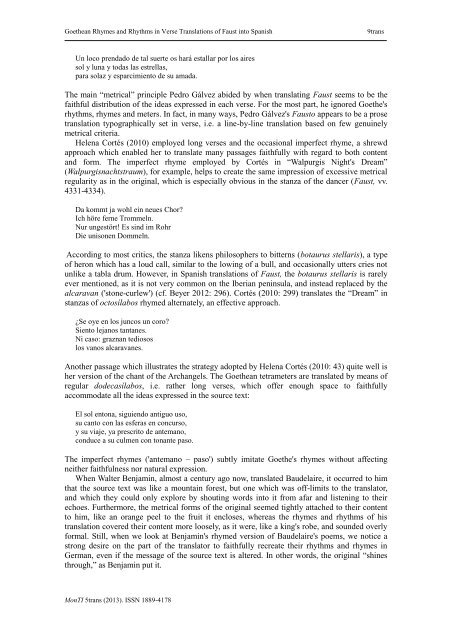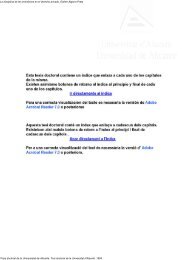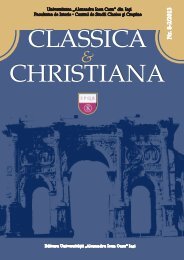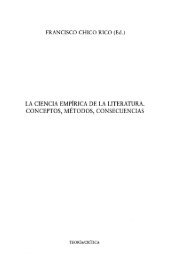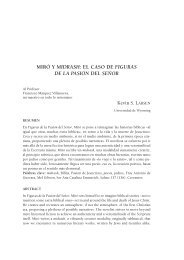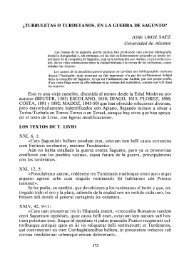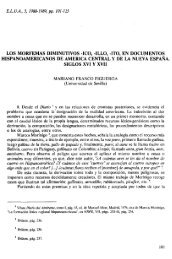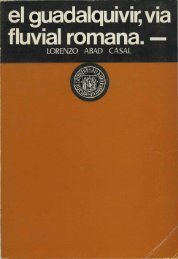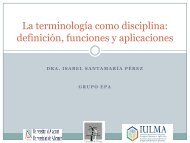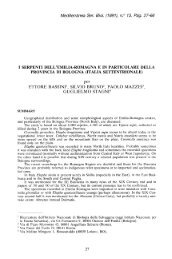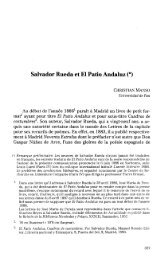goethean rhymes and rhythms in verse translations of faust ... - RUA
goethean rhymes and rhythms in verse translations of faust ... - RUA
goethean rhymes and rhythms in verse translations of faust ... - RUA
You also want an ePaper? Increase the reach of your titles
YUMPU automatically turns print PDFs into web optimized ePapers that Google loves.
Goethean Rhymes <strong>and</strong> Rhythms <strong>in</strong> Verse Translations <strong>of</strong> Faust <strong>in</strong>to Spanish<br />
9trans<br />
Un loco prendado de tal suerte os hará estallar por los aires<br />
sol y luna y todas las estrellas,<br />
para solaz y esparcimiento de su amada.<br />
The ma<strong>in</strong> “metrical” pr<strong>in</strong>ciple Pedro Gálvez abided by when translat<strong>in</strong>g Faust seems to be the<br />
faithful distribution <strong>of</strong> the ideas expressed <strong>in</strong> each <strong>verse</strong>. For the most part, he ignored Goethe's<br />
<strong>rhythms</strong>, <strong>rhymes</strong> <strong>and</strong> meters. In fact, <strong>in</strong> many ways, Pedro Gálvez's Fausto appears to be a prose<br />
translation typographically set <strong>in</strong> <strong>verse</strong>, i.e. a l<strong>in</strong>e-by-l<strong>in</strong>e translation based on few genu<strong>in</strong>ely<br />
metrical criteria.<br />
Helena Cortés (2010) employed long <strong>verse</strong>s <strong>and</strong> the occasional imperfect rhyme, a shrewd<br />
approach which enabled her to translate many passages faithfully with regard to both content<br />
<strong>and</strong> form. The imperfect rhyme employed by Cortés <strong>in</strong> “Walpurgis Night's Dream”<br />
(Walpurgisnachtstraum), for example, helps to create the same impression <strong>of</strong> excessive metrical<br />
regularity as <strong>in</strong> the orig<strong>in</strong>al, which is especially obvious <strong>in</strong> the stanza <strong>of</strong> the dancer (Faust, vv.<br />
4331-4334).<br />
Da kommt ja wohl e<strong>in</strong> neues Chor?<br />
Ich höre ferne Trommeln.<br />
Nur ungestört! Es s<strong>in</strong>d im Rohr<br />
Die unisonen Dommeln.<br />
Accord<strong>in</strong>g to most critics, the stanza likens philosophers to bitterns (botaurus stellaris), a type<br />
<strong>of</strong> heron which has a loud call, similar to the low<strong>in</strong>g <strong>of</strong> a bull, <strong>and</strong> occasionally utters cries not<br />
unlike a tabla drum. However, <strong>in</strong> Spanish <strong>translations</strong> <strong>of</strong> Faust, the botaurus stellaris is rarely<br />
ever mentioned, as it is not very common on the Iberian pen<strong>in</strong>sula, <strong>and</strong> <strong>in</strong>stead replaced by the<br />
alcaravan ('stone-curlew') (cf. Beyer 2012: 296). Cortés (2010: 299) translates the “Dream” <strong>in</strong><br />
stanzas <strong>of</strong> octosílabos rhymed alternately, an effective approach.<br />
¿Se oye en los juncos un coro?<br />
Siento lejanos tantanes.<br />
Ni caso: graznan tediosos<br />
los vanos alcaravanes.<br />
Another passage which illustrates the strategy adopted by Helena Cortés (2010: 43) quite well is<br />
her version <strong>of</strong> the chant <strong>of</strong> the Archangels. The Goethean tetrameters are translated by means <strong>of</strong><br />
regular dodecasílabos, i.e. rather long <strong>verse</strong>s, which <strong>of</strong>fer enough space to faithfully<br />
accommodate all the ideas expressed <strong>in</strong> the source text:<br />
El sol entona, siguiendo antiguo uso,<br />
su canto con las esferas en concurso,<br />
y su viaje, ya prescrito de antemano,<br />
conduce a su culmen con tonante paso.<br />
The imperfect <strong>rhymes</strong> ('antemano – paso') subtly imitate Goethe's <strong>rhymes</strong> without affect<strong>in</strong>g<br />
neither faithfulness nor natural expression.<br />
When Walter Benjam<strong>in</strong>, almost a century ago now, translated Baudelaire, it occurred to him<br />
that the source text was like a mounta<strong>in</strong> forest, but one which was <strong>of</strong>f-limits to the translator,<br />
<strong>and</strong> which they could only explore by shout<strong>in</strong>g words <strong>in</strong>to it from afar <strong>and</strong> listen<strong>in</strong>g to their<br />
echoes. Furthermore, the metrical forms <strong>of</strong> the orig<strong>in</strong>al seemed tightly attached to their content<br />
to him, like an orange peel to the fruit it encloses, whereas the <strong>rhymes</strong> <strong>and</strong> <strong>rhythms</strong> <strong>of</strong> his<br />
translation covered their content more loosely, as it were, like a k<strong>in</strong>g's robe, <strong>and</strong> sounded overly<br />
formal. Still, when we look at Benjam<strong>in</strong>'s rhymed version <strong>of</strong> Baudelaire's poems, we notice a<br />
strong desire on the part <strong>of</strong> the translator to faithfully recreate their <strong>rhythms</strong> <strong>and</strong> <strong>rhymes</strong> <strong>in</strong><br />
German, even if the message <strong>of</strong> the source text is altered. In other words, the orig<strong>in</strong>al “sh<strong>in</strong>es<br />
through,” as Benjam<strong>in</strong> put it.<br />
MonTI 5trans (2013). ISSN 1889-4178


